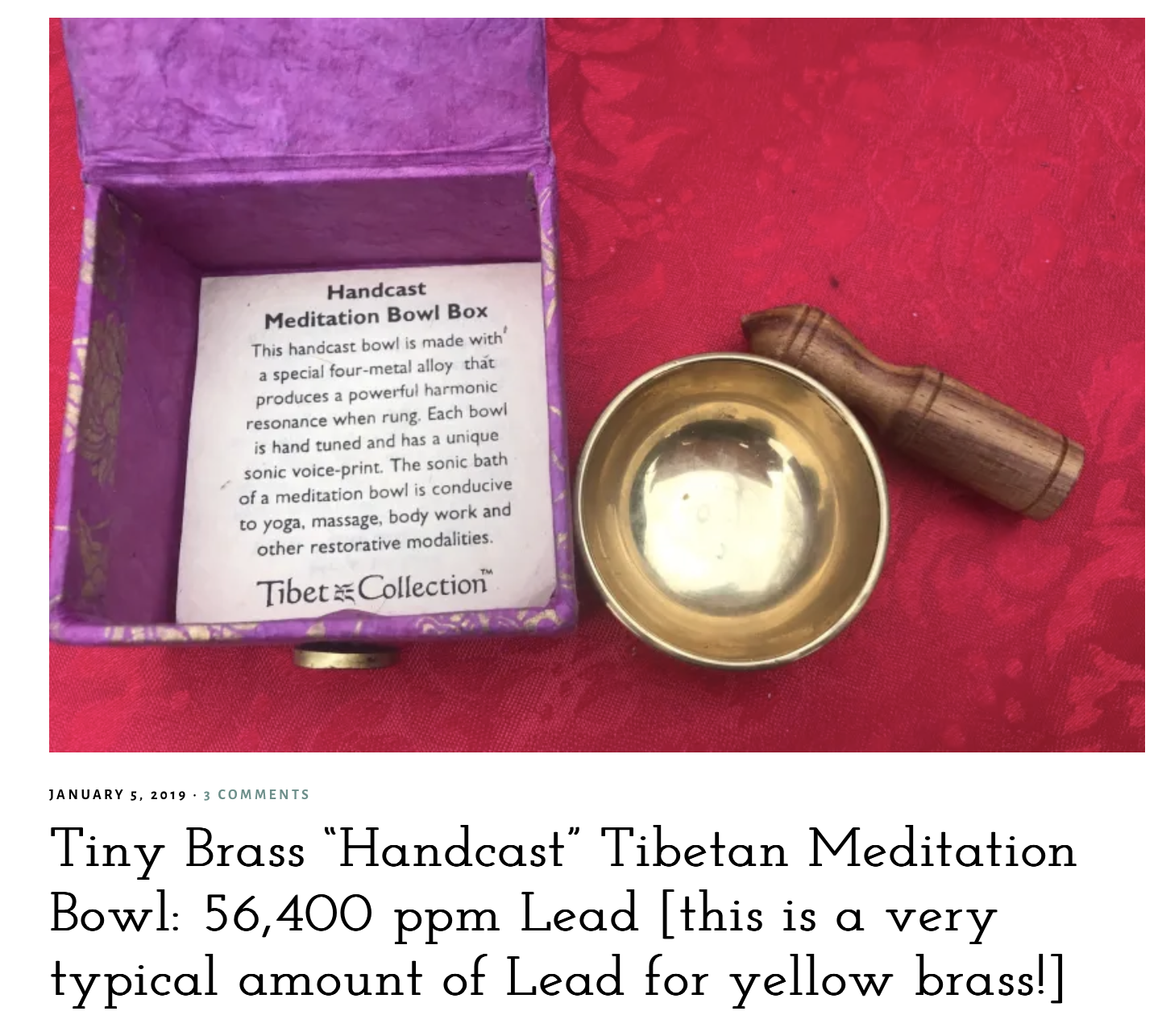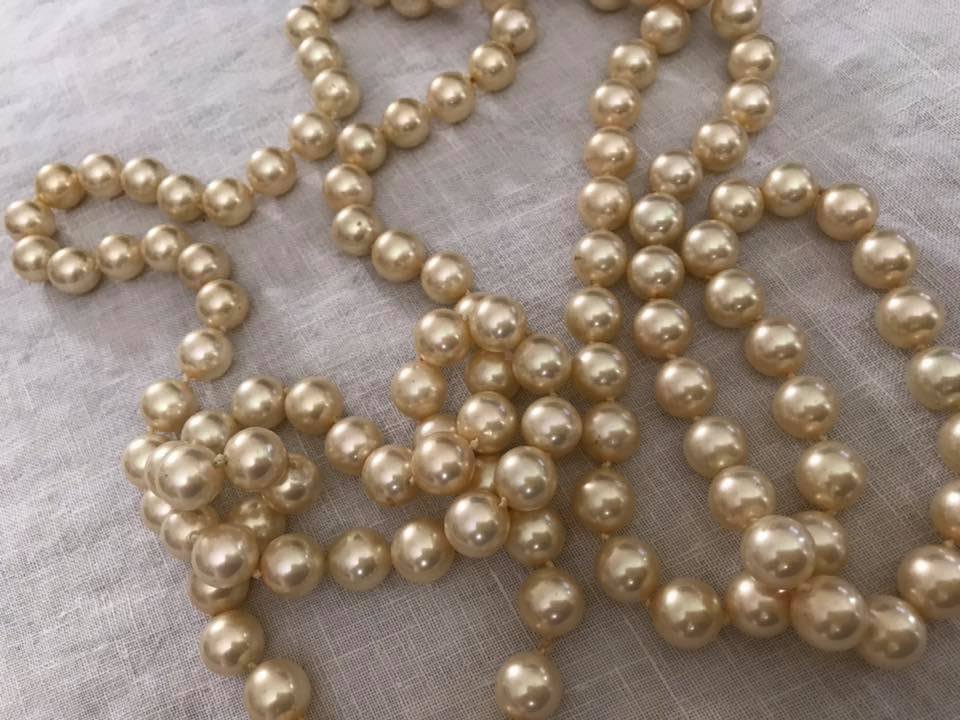But is this dish or toy or lamp or vitamin or piece of jewelry (or Tibetan brass singing bowl!) ACTUALLY going to poison me? And how would that happen, exactly?
Published: June 12, 2021
Updated: August 1, 2023
For those new to the Lead Safe Mama website:
Tamara Rubin is a multiple-federal-award-winning independent advocate for childhood Lead poisoning prevention and consumer goods safety, and a documentary filmmaker. She is also a mother of Lead-poisoned children (two of her four sons were acutely Lead-poisoned in 2005).
- Tamara owns and runs Lead Safe Mama, LLC — a unique community collaborative woman-owned small business for childhood Lead poisoning prevention and consumer goods safety.
- Since 2009, Tamara has been conducting XRF testing (a scientific testing method) using the exact instrumentation employed by the U.S. Consumer Product Safety Commission to test consumer goods for toxicants (specifically heavy metals — including Lead, Cadmium, Mercury, Antimony, and Arsenic).
- Since July of 2022, the work of Lead Safe Mama, LLC has been responsible for 5 product recalls (FDA and CPSC).
- All test results reported on this website are science-based, accurate, and replicable.
- Items that Lead Safe Mama, LLC reports on are tested multiple times to confirm the results published (for each component tested).
- Recent notable press… There has been too much to mention already in 2024! Please check out our press page to see some of the amazing coverage of our work so far this year!
This is an ad-free article.
Advertising and affiliate income help us cover the costs of the work we do here (independent consumer goods testing and childhood Lead-poisoning prevention advocacy). We have removed ads from most of our more widely-read articles (like this one!) to make them easier for you to read. In addition to supporting this work by starting any shopping you might be doing with clicks on our affiliate links, if you would like to support our independent consumer goods testing and childhood Lead-poisoning prevention advocacy work by making a contribution (which will also help us keep our more widely-read articles ad-free), click here. Thank you!
In response to my sharing the above article about a singing bowl with Lead, a reader asked the following question on Facebook:
“I hope you don’t mind me asking a very novice question. When metals are cast like this and then touched with human hands can the Lead actually leach out onto our hands and then eventually enter into our bodies?”
Tamara’s Response:
It is normally hand-to-mouth activity that’s a concern — frequent, repeated hand-to-mouth interaction with a potentially high-Lead object (that might be held/touched frequently — or even used as a fidget by a child — like the small bowl pictured here). Normal hand-to-mouth activity like …
- handling your high-Lead bowl, picking up your coffee cup by the brim — and then drinking your tea— without washing your hands after touching the high-Lead item.
- handling your high-Lead item (keys, singing bowl, leaded jewelry, etc.), and then picking up an apple and eating it (or picking up tortilla chips and eating them — licking the salt off of your fingers afterwards as one does) without washing your hands before you handle your food.
- handling a high-Lead-content item (like the high-Lead faux pearls pictured below) and then unconsciously putting your fingertip into your mouth, biting your nails, etc.
An isolated interaction is not normally a concern.
In most cases (with few exceptions), one usage of one thing like this (one time) is not going to “POISON” you. Said another way: touching a Leaded item once is unlikely to directly contribute to any kind of a measurable change in Blood Lead Level today. However, interacting with (and specifically touching with your bare hands, holding/handing or otherwise using) high Lead consumer goods on a regular basis (or even periodically) could contribute to the potential aggregate (cumulative) background Lead exposure in your life (and body) over time.
Why should we be concerned about Lead in consumer goods?
- Lead is a potent neurotoxicant and disrupts all biological functions.
- “Most of the Lead that has ever gone into your body is still there!” — per Dr. Bruce Lanphear’s statement in my film.
- As a result, whenever we can avoid any potential sources of Lead, we should (especially in cases where inexpensive Lead-free alternatives are plentiful and readily available)!
- Given the potent toxicity of Lead, we should strive to eliminate Leaded items from our life whether or not any scientific body has been able to definitively demonstrate a potential risk of exposure for that specific type of item, given either normal regular use as intended or any potential exposure resulting from a single use.
- We should strive to avoid any and all potential sources of Lead because there is no “safe” level of Lead exposure for human beings.
- We should avoid any potential sources of Lead because we cannot count on manufacturers/ importers/ distributors to evaluate or understand the potential health impacts of the products they make (like this singing bowl), as doing so would likely negatively impact their bottom line.
Corporations don’t care.
Of course — as Upton Sinclair famously pointed out — it is often in their interest (as a manufacturer) for a company to not know or understand these things. And, as such, most of this — the presence of so many different heavy metal toxicants in consumer goods in use in our homes today — is not regulated at all because there is no agency or business that would financially benefit (or not be financially negatively impacted) from confirming whether or not a particular Leaded brass item (or other high-Lead content items) might cause harm when used “as intended.” And, separately when used as could reasonably be anticipated, by a child, were they to handle or otherwise interact with the object (regardless of the maker’s ostensible “intended consumer” of the product).
Government agencies couldn’t possibly step up.
With the enormous quantity of consumer goods on the planet (coming from every country and made of every possible material) it is also not possible for any government agency to properly assess these risks on our behalf, so we have to take this on ourselves and make educated choices that are safest for our families (with the information available to us in the ABSENCE of comprehensive scientific testing and evaluation of the risk of ALL THINGS).
So again, in the words of another scientist/researcher highlighted in my film, Mark Pokras, together we should strive for a world where the policy is that “Thou shalt not use Lead in anything.”
The best way to get from here to there is to start eliminating consumer goods from our lives that we know to have unsafe levels of Lead. And perhaps (we can at least hope) this will eventually eliminate the market for these products, which may in turn push manufacturers to cease the creation of Lead-containing products.
As always, thank you for reading and for sharing Lead Safe Mama articles with your friends and communities. Please let me know if you have any questions and I will do my best to answer them as soon as I have a (kid-free) moment.
Tamara Rubin
Owner — Lead Safe Mama, LLC
#LeadSafeMama
Click the image below to read more about these high-Lead vintage faux pearls.
Never Miss an Important Article Again!
Join our Email List












Hi Tamara, I appreciate you writing this out. I am still confused- if there is an item- this brass bowl, for example- and it is only used for decoration, high on a shelf, out of reach of children- could this pose any harm? Does the lead oxidize and create dangerous dust on something like this or perhaps a ceramic bowl? Also, how does the lead transfer when this bowl is handled? If I touch it – does lead stick to my skin? Bad example but, If I touch a kernel of corn- none of the corn transfers on to my skin, and in turn potentially into my body if I was to touch the rim of a cup and then drink from it- so I’m just curious how the lead comes off the bowl when touched. Sorry for the confusion- just genuinely curious and want to have the best understanding – especially as I try to explain these things to others. I feel like a frequently used dish in the kitchen, leaching lead into food makes sense, but I was confused to read that just touching a leaded item (bowl, key, toy, jewelry, etc.) you could expose yourself to lead ingestion (rim of cup example) Thank you, thank you, THANK YOU for all the work you’re doing! You’re changing the world for the better!
Hi Jess – thanks for commenting,
When you are talking about high Lead brass (50,000 ppm Lead) or high Lead crystal (like 300,000 ppm -or similar with the pearls – which are also painted in Lead paint) the particulates can wear off on to your hands when they are touched for sure. Here’s a post that discusses the degree to which microscopic particulates are a concern:
https://tamararubin.com/2019/03/the-sugar-packet-analogy-how-much-lead-dust-does-it-take-to-poison-a-child/
Brass and crystal in general can also contribute to the contamination of house dust. Here’s a post that discusses that: https://tamararubin.com/2019/11/waterford-leaded-crystal-bud-vase-386000-ppm-lead-39-lead-leaded-crystal-items-can-passively-create-lead-dust-in-your-home/
Tamara
When washing my Corelle Snowflake dishes in the dishwasher, does the lead from the blue decorative design which is said to be leaded, transfer in the dishwasher to other dishes, or to the white unleaded areas of the dish?
The dishwasher is not the problem- the lead is in the glaze so when you eat food off the plate little bits of lead are in your food.
The lead is in the glaze? Or the paintings of the plates? I consider simple all white plates safer options
Hi Tamara,
I bought a small decorative case for my nightstand, and a couple if days ago I realized a warning in it stating that it contained lead. Does it project any harm by being on my bedside table?
I would have to see it to evaluate any potential concern. You can join the Lead Poisoning Prevention with Lead Safe Mama Facebook group and post a photo if you like.
T
I have been taking The Doctors Best High Absorption Lysinate Glycinate Capsules everyday for almost 2 years now. I usually take 3 capsules before I go to sleep, will these capsules end up harming organs in my body or killing me through lead poisoning? Should I cease taking them immediately? I showed my long time doctor I was taking them and he said that they are ok to take. So now I am very confused. Thank You for your reply.